Tomato Canning: Basic, Marinara, and Pizza Sauce
Two years ago, I wrote a rather desperate post about my first experience in bulk tomato canning. I scarcely realized the task I had undertaken, did not have pots quite large enough or a food mill worth its weight in feathers, and I had unwittingly committed to waaaaay to many products for a two-day stint. At the time, I wasn’t sure it was worth the effort, and there are least a few moments that tears dripped down my tomato-flecked face.
But over the course of that year, I grew quite fond of the sauces I had made and became rather dependent on them in my cooking. When tomato season rolled around again, I decided to tackle the project a second time with a few changes. I reduced the variety of products, but I also added about 25% more tomatoes since I had run out of many favorites in the weeks previous. However, the project still produced a vast amount of stress. I had to do my canning at a friend’s apartment (I didn’t have the right kind of stove to manage it), which meant packing up all my supplies and commandeering a kitchen that was not my own. More tomato-stained tears were had.
They say third time is the charm, and in this case I agree: I tackled my tomatoes this year with some MAJOR upgrades that turned this somewhat dreaded experience into an exciting one.
I know many of you are completely uninterested in large-scale canning. Even with upgraded equipment and a few years of experience, putting up 120 pounds of tomatoes (!!!) is a massive amount of work. However, if you are interested but have not approached the craft because it seems too daunting, I want to share with you a few of the things I’ve learned that I wish so much I had known the first time around.
Get the Right Tools
I know this sounds like a no-brainer. Canning requires lots of unique tools, many of which are now finally available at average grocery stores. But honestly, I am thoroughly convinced that the biggest key to my success this year centered around two new items: a really, really big cooking pot and an electric tomato strainer.
Let’s talk about the pot for a minute. For the last two years, I’ve cooked my batches of tomatoes in a 6-quart pot, which only left about two inches of space at the top for the pureé to bubble along for over an hour. The result is tomato splatter ALL OVER THE KITCHEN. This year, I invested in a 16-quart stainless steel pot, which seemed absurdly huge. However, even though my raw tomato puree filled only about a third of the pot, the splatter that used to bloody my walls and stove now stays merrily inside.
As for the strainer. Brad gave me mine, a tremendous gift, after he’d asked what one item I would splurge on for myself. He went all out and bought me this one, an Italian model with good reviews and a sturdy motor that should last for years to come. There are a variety of others out there, as well. Normally, I’m not a fan of one-trick ponies in the kitchen, let along ones that only come out once a year.
But let me tell you: after two years of washing, scoring, blanching, cooling, peeling, slicing, seeding, and pureéing one tomato at a time, for over 100 pounds, the strainer was EVERYTHING. Wash tomato, slice in half if large, put into strainer, receive beautiful pureé in one pot and seeds and skins in another. What used to take two-three hours for a batch now takes 30 minutes. If you can bulk tomatoes, I can’t recommend it enough.
Can What You’ll Actually Eat
The first year, I tried all kinds of things: sweet relish, ketchup, three kinds of salsa, pickled okra, and three kinds of tomato sauce. I used the tomato sauce and most of the other cans sat dormant. The second year, I canned whole tomatoes, diced tomatoes, and three kinds of tomato sauce. I used the tomato sauce and most of the other cans sat dormant.
I’m not saying you shouldn’t try new recipes. But if a bulk-canning weekend is what you’re aiming for, I find that the fewer recipes I’m working with on those two days improves my efficiency tremendously. Starting with the easiest first, a rhythm develops that makes the whole day (or weekend) flow smoothly. This year, with just over 120 pounds of tomatoes, I finished in 14 hours, a record one-day can-a-thon for me, making multiple batches of only three kinds of tomato sauce.
Prep Your Kitchen the Night Before
On Friday night, I pick up my bulk order of tomatoes. I do my grocery-shopping to collect the other ingredients. I schlepped out my canner, cooking pots, scrap bowls, jars, lids, cookbooks, towels, and canning tools. I lay out towels for filling jars and for resting them once they’re canned.
Why stretch this process out? Canning day is a lot of work, a lot of standing on your feet in a steamy kitchen over boiling pots and boxes of tomatoes. I hate preceding that with a couple hours of cleaning and organizing and much prefer to wake up to a kitchen that’s ready to go.
Be Prepared for HARD Work
Even with the tremendously-time-saving tools I gained this year, my back still screamed with pain by the time I hit the third box of tomatoes. My arms ached from pressing 120 pounds of tomatoes through a hole the size of a half-dollar in the tomato strainer. Slowly, the tomato boxes drained, and my kitchen table filled with glimmering ruby jars. All told, at the end of the night, there is always a little bit of anti-climactic disappointment at the resulting jars. The volume of 50-some jars is so much smaller than the huge boxes I started with.
I was extremely caught off-guard the first year by the work. Now, I know what’s coming, so I’m better able to prepare for it. I had Brad bring me lunch in the middle of the day so I could keep working efficiently, and I stocked up on snacks in advance to avoid while hangry (a dangerous mix under any circumstance.) I wear good shoes and comfy clothes, and I stretch and break when I need to. By treating it like an event, planning in advance what I’ll need, and giving myself every opportunity to be successful, the resulting work feels much for acceptable.
Finally, Savor Your Efforts
You could absolutely go and buy tomato sauce of varying kinds at the grocery store. It will probably cost you less (unless you’re lucky enough to be growing your own tomatoes in which case I’m quite envious) and will taste just fine.
Canning your own food is not about beating the best price at the grocery store. The cost we pay for cheap groceries comes in other forms: unsustainable growing, often inferior products, additives and preservatives, low wages, incentive to be wasteful, the list goes on and on.
Each jar of tomato sauce on my shelf is special to me. I’m proud of the work I’ve put in to support a local grower. I like knowing exactly what’s in my sauce. I like always having some on hand (except for those scary days in August when I’m running low on last year’s supply.) I am cautious to never waste a drop, probably because I remember the back pain and sweat and effort that went into producing it.
And simply put, it’s delicious. It does take a bit of time to get used to when you’ve grown up on grocery-store sauces. But now that we have, Brad and I can hardly imagine not having these staples in the pantry year-round. One long weekend of work yields almost 8 weeks of meals. Not to shabby, I think.
The Recipes
Below are the three recipes I canned this year. After two earlier years of trying a variety of different recipes, these are the ones I use the most consistently in my kitchen. They’re extremely versatile, and don’t require a huge number of additional ingredients. I can in batches large enough to fill my water bath canner with jars, usually 8-9 pints at a time. If you’re curious, I canned this year four batches of Basic Tomato Sauce (yielding 29 pints), two batches of Marinara Sauce (yielding 17 pints), and one batch of Pizza Sauce (yielding 15 half pints.)
The recipes below do NOT outline basic canning safety procedures. For those, I highly recommend the two cookbooks I adapted my recipes from: The Food in Jars Cookbook, and the Ball Complete Book of Home Preserving. They are tremendous resources. Plus, you’ll likely find other recipes that you love in each and maybe even add them to your canning agenda.
Basic Tomato Sauce
Adapted from Food in Jars
Makes 8-9 pints
20 pounds paste tomatoes (Roma or San Marzano)
2 tsp salt
1 T lemon juice per pint jar
Wash tomatoes. If using a tomato strainer, run tomatoes through strainer to collect all puree in a large pot. If not using a strainer, cut a small “x” in the skin of the non-stem end of the tomato and remove the core of the stem end. Bring a medium pot of water to a boil and blanch a few tomatoes at a time for 1-2 minutes. Remove with a slotted spoon to a bowl of ice water to stop the cooking. Peel off the skins into a scrap bowl, then slice each tomato in half. Use your fingers to remove the seeds into the scrap bowl. Pureé peeled and seeded tomatoes in a food processor or blender and pour in a large pot.
Add salt to the tomato pureé and stir well. Bring to a boil. Once boiling, reduce heat to medium-high and cook for 60-75 minutes without a lid, stirring frequently. The sauce should reduce be almost half.
While the sauce is cooking, prepare your jars and water bath canner.
Once the sauce is nearly done, add 1 tablespoon of lemon juice to each prepared jar. Pour the hot tomato sauce into the jars, leaving 1/2″ of headspace. Wipe the rims and place the flat lids on each jar. Add rings and spin to finger-tight. Process in a boiling water bath for 35 minutes. Note, you will need longer processing time if you live at an altitude higher than 1000 feet. Consult a canning cookbook for recommended additional time.
Remove jars from canner and let sit undisturbed for 12-24 hours. Ensure lids have sealed and store in a cool, dark place.
Marinara Sauce
Adapted from Food in Jars
Makes 8-9 pints
Note: Do not add extra onion or garlic. They are low in acid and could make your final product unsafe for long-term storage.
20 pounds paste tomatoes (Roma or San Marzano)
2 tsp olive oil
1 cup (160 g) finely chopped yellow onion
6 cloves garlic, finely chopped
2 tsp salt
1/4 c finely chopped fresh basil
1/4 c finely chopped fresh flat-leaf parsley
1 1/2 T lemon juice per pint jar
Wash tomatoes. If using a tomato strainer, run tomatoes through strainer to collect all puree in a large bowl or pot (not the pot you’ll use for cooking). If not using a strainer, use the method outlined in the Basic Tomato Sauce recipe to skin, seed, and pureé the tomatoes.
Heat olive oil in your cooking pot over medium heat. Add onions, garlic, and salt and sauté for 5-6 minutes until the onion is translucent. Add tomato pureé, basil, and parsley and stir well. Bring to a boil. Once boiling, reduce heat to medium-high and cook for 70-80 minutes without a lid, stirring frequently. The sauce should reduce be about half.
Once the sauce is nearly done, add 1 1/2 tablespoons of lemon juice to each prepared jar. Pour the hot tomato sauce into the jars, leaving 1/2″ of headspace. Wipe the rims and place the flat lids on each jar. Add rings and spin to finger-tight. Process in a boiling water bath for 35 minutes. Note, you will need longer processing time if you live at an altitude higher than 1000 feet. Consult a canning cookbook for recommended additional time.
Remove jars from canner and let sit undisturbed for 12-24 hours. Ensure lids have sealed and store in a cool, dark place.
Pizza Sauce
Adapted from the Ball Complete Book of Home Preserving
Makes 8-9 pints (I can mine in half-pints, which each make one pizza perfectly)
20 pounds paste tomatoes (Roma or San Marzano)
4 tsp dried oregano
2 tsp freshly ground black pepper
2 tsp salt
2 tsp garlic powder
1 T lemon juice per half-pint jar (or 2 T per pint jar)
Wash tomatoes. If using a tomato strainer, run tomatoes through strainer to collect all puree in a large pot. If not using a strainer, use the method outlined in the Basic Tomato Sauce recipe to skin, seed, and pureé the tomatoes.
Add oregano, pepper, salt, and garlic powder to the tomato pureé and stir well. Bring to a boil. Once boiling, reduce heat to medium-high and cook for 70-80 minutes without a lid, stirring frequently. The sauce should reduce be about half.
While the sauce is cooking, prepare your jars and water bath canner.
Once the sauce is nearly done, add 1 tablespoon of lemon juice to each prepared half-pint jar. Pour the hot tomato sauce into the jars, leaving 1/2″ of headspace. Wipe the rims and place the flat lids on each jar. Add rings and spin to finger-tight. Process in a boiling water bath for 35 minutes. Note, you will need longer processing time if you live at an altitude higher than 1000 feet. Consult a canning cookbook for recommended additional time.
Remove jars from canner and let sit undisturbed for 12-24 hours. Ensure lids have sealed and store in a cool, dark place.

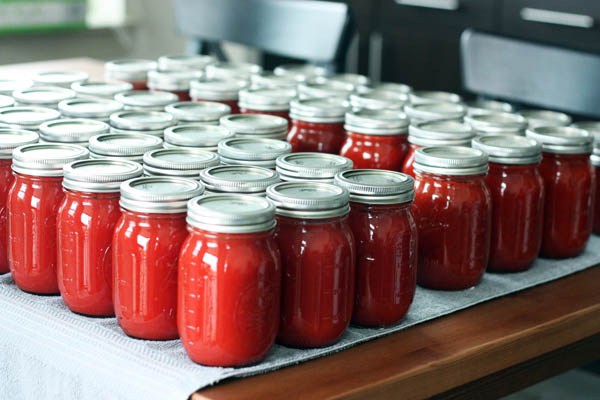
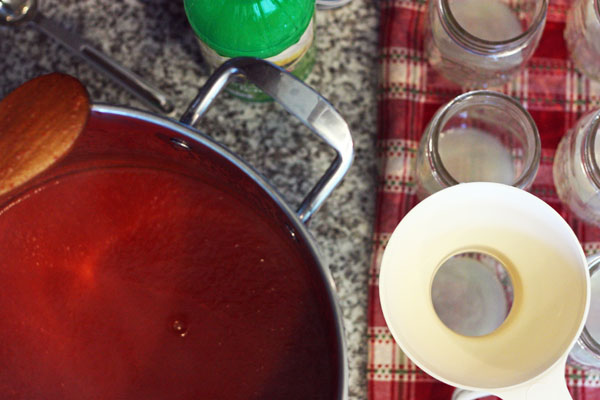
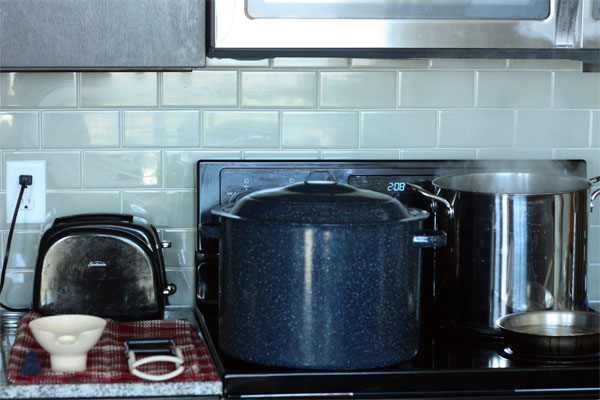
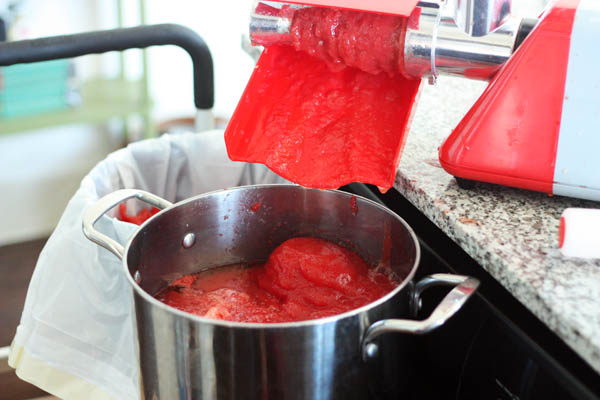
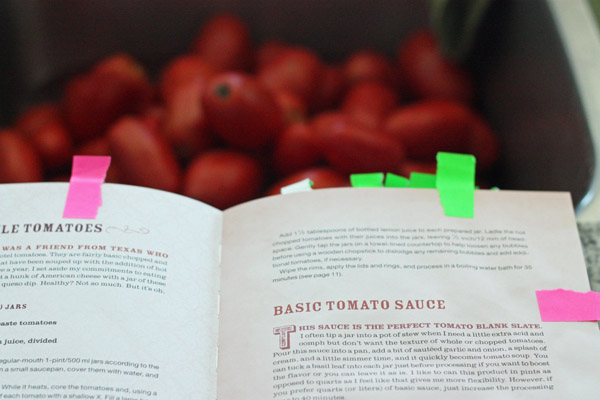
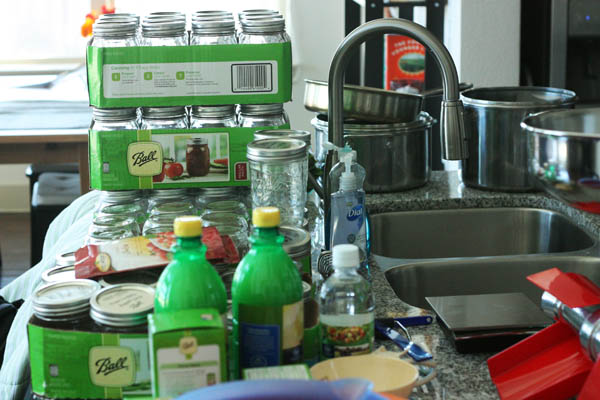
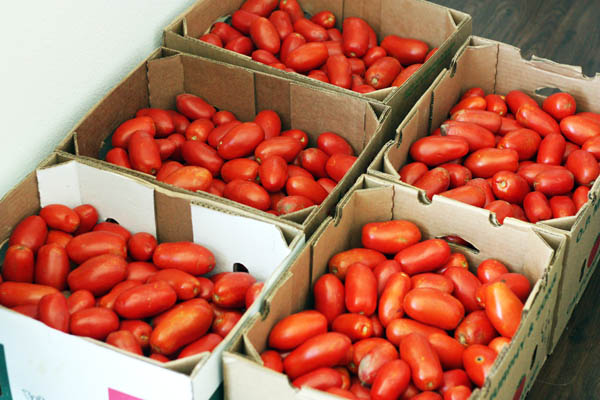
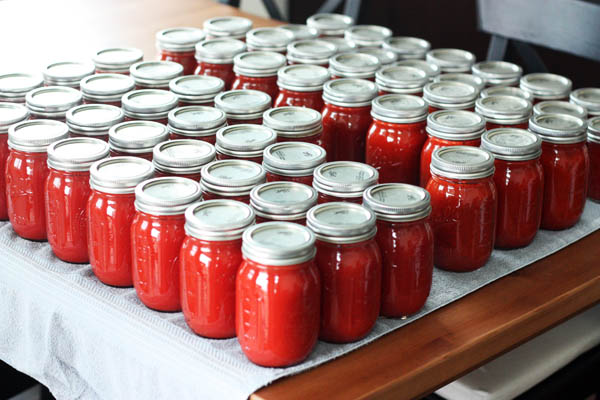
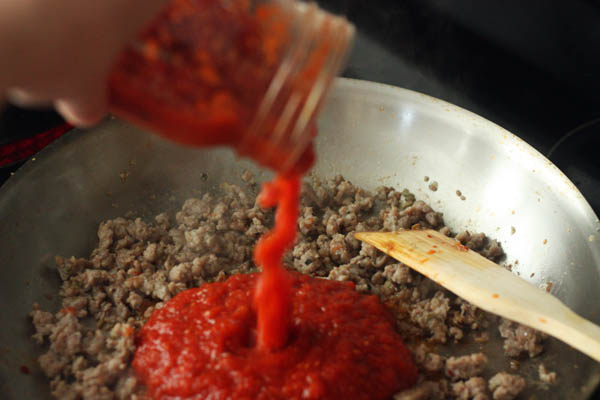





Martin
October 5, 2015 @ 2:27 am
This is so cool
C
November 12, 2015 @ 10:30 pm
question: Do you have to do all the processing of the tomatoes beforehand (blanching, peeling, seeding, etc)? When I make normal (aka not for canning) tomato sauce at home, I don’t do any of that. Is it required or just for taste/texture?
Sara
July 19, 2018 @ 9:33 am
Are you ready I am about to blow your mind. Take your Roma’s cut steam area off. Quarter them. Add spices. I like a lot of different ones; ground the garlic and onion in a food processor. Add tomatoes, onions and garlic to an electric roaster. I put mine out in the mud room and let it cook for about 8 hours. Use an immersible blender and make it look like sauce add to jars and cool pack it.
Michelle
August 31, 2018 @ 1:23 am
I had 20 pounds left and was looking for a pizza sauce recipe. Thanks for posting your. This is such a great post for tomato canning. It has inspired me to look for more tomatoes before the season is over. And I concur that the greatest blessing for this type of work project is the electric strainer!
My query is lemon juice versus citric acid? Any thoughts?